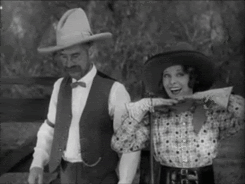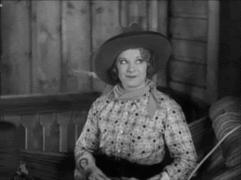
For my third,
and for the moment final, piece on Marjorie Beebe I have singled out Cowcatcher’s Daughter (Babe Stafford
1931) for special attention. There are a number of reasons for this. Firstly it
was the swansong of Beebe’s most regular role, Marge Martin, the misbehaving
daughter of Andy Clyde’s Pop Martin, so she was at her most outrageous.
Secondly it was a reprise of her old Fox triumph we have spoken of before, The Farmer’s Daughter (Arthur Rosson
1928), so it would have meant something special to her. Thirdly it’s a
wonderful romp named for and written around her. And it could almost have been
written to order for a site called Let’s Misbehave. If you want a logline for Cowcatcher’s Daughter try “Marjorie Beebe Misbehaves”.
But there’s
another reason. Cowcatcher is a rather exquisite example of a very old form, an
antic dance in aspic, a tale that had
been told since the days of troubadors and Meistersingers. It’s a Harlequinade.
The story of Harlequin and Columbine crystallized in commedia dell’ arte and passed into the English speaking world at
the Restoration, eventually becoming pantomime which gave many a Brit such as I
his or her first introduction to traditional storytelling. Harlequin is a
prankster and a shapeshifter who sets his cap at the lovely Columbine. She is
set to wed Fool, her crabby old father Pantaloon’s man. Harlequin has to
outsmart Pantaloon.
As soon as Andy
Clyde, a wonderful actor with a career that lasted into television Westerns of
the 1960s, but at the time only in early middle age, perfected his old man
routine through innovative experiments in make-up, supported by costume,
attitude and delivery, Mack Sennett was ready to make Harlequinades. For Clyde, knowingly or not, had recreated
old Pantaloon, and since his origins lay in Scottish music hall I suspect he
knew all about Harlequinades. Of course nothing that came out of the madcap
mayhem of Mack Sennett’s studios was entirely set in aspic; Sennett was a Janus
figure looking back on centuries of popular entertainment while looking forward
to the boundless new possibilities of cinema, and by this stage sound cinema.
And there was
one huge difference from the Harlequinades of old- Marjorie Beebe herself. She
turned the Harlequinade upside down. She was the prankster now not Harlequin.
And given her bravura acting she was something of a shapeshifter as well, essentially
playing different characters when with Harlequin, now an oh so handsome itinerant
cattle inspector, Fool, her father’s dolt of a foreman and Marge’s fiancé, and
Pantaloon, already introduced. Marjorie Beebe, hidden away in these obscure two
reel shorts, has not been given credit for what she did to the old story. This
Americanized Harlequinade, transformed into that quintessentially American form
the Western, starred a girl who was constantly prepared to take the men on at
their own game while never losing sight of her femininity.
Incidentally Cowcatcher’s Daughter provides one of
the few examples I know of the word “cowcatcher” being used to describe a man
rather than those devices placed on the front of American trains to push cows
off the track. The film was shot on location in the beautiful San Fernando
Valley which gives it a much more open and expansive feel than most Mack
Sennett shorts. Given it was made only a very few years after the coming of
sound it’s really rather an impressive technical achievement apart from
anything else. It’s easy to forget just how innovative generally Mack Sennett
and his behind the scenes crew (which included William Hornbeck) were.

I described Marjorie
Beebe’s antics before as 24 carat misbehavior. They certainly encompass a lot
more than Columbine would once have done, which was basically just to flirt
with a handsome stranger behind her fiancé’s back- and anyway in Beebe’s case she
does it in front of him as well! Clyde is not even aware of this fellow when the
show opens, but he’s still hopping mad with his disorderly daughter. In a
previous Marge Martin romp, Campus
Crushes (Mack Sennett 1930), she
had fooled around at college. Now she has upped sticks entirely and joined a
circus as a trick rider. She does so well that the circus folk put her on their
posters and, unfortunately for her, one falls into her old father’s hands. The
hapless foreman is sent to retrieve her- if he fails, warns Clyde, there will
be no marriage. So he finds her, and gets treated to plenty of delicious sass
on the long journey home.
MARGE: There are a lot of things I don’t like, Jim. One of them’s school and the rest are you.
JIM: Me! Why my old Ma said I had more in my head than all the other boys put together. Now how
do you suppose she found that out?
MARGE:
With a fine comb?
Respect for one’s
elders, let alone one’s apparent future husband, is certainly not on the menu. He
puts her on the back of his own horse so she can’t gallop away from him, and
facing the horse’s tail in disgrace. Unfortunately for him that only makes
matters worse when Harlequin, now known as Mr Thornby the cattle inspector, drives
up behind them in a new-fangled open top car- this is a contemporary horse
opera, set when it was made. Future marriage vows and engagements are of as
little moment to Marge as respect, and she sets about shamelessly flirting with
the handsome intruder until the horse gets spooked by the car and careers away at
full speed to the Martin ranch. Marge Martin will arrive home decked out in all
her cowgirl clobber from her big hat to her ornate boots, and halfway down a
rather strange almost fetishy looking belt or corset cinching in her waist; the
sexy trick rider has been displaying her curves and her charm in equal measure
to her adoring circus-going public.

Her currently
less than adoring father is waiting for her on the veranda. It’s time for Marge
Martin to come down off her high horse. As the title implies this little Harlequinade
centers on the tussles between father and daughter, Pantaloon and Columbine.
The two younger men are slightly sidelined, both as far as the script goes and
the acting talent on show. Beebe bats for Mr Thornby and Clyde for the foreman
but who will win the day? Really though the film is about how outrageously
Beebe can behave and whether Clyde is still enough of a father to control her-
he certainly isn’t going to get any help from the foolish fiancé of a foreman,
the latest in a long line of sops trying to woo Marjorie Beebe.
As far as the
former goes this is misbehaving Ms Beebe at her best. Apart from running away
to that circus she also sneaks out of the ranch at night to go nude swimming.
What few clothes she has at the lakeside get stolen and she has to return home
as dawn is breaking naked save for hat and boots. She walks behind a barred
fence. There is a gap ahead. We wait. As she comes to the gap, and almost
playing with the audience, she closes an obscured gate and walks on.

She also
continues to flirt outrageously with the cattle inspector. And there is a fifth
star to this Harlequinade as filtered through pantomime, her horse Trixie. The
beast adds a further delightful element to the proceedings. Wicked Marge has
trained Trixie not only to remove her fiancé’s hat and throw it down the well
but also to push the poor fellow down after it. There is also a delightful
scene between Marge and Trixie when they “talk” about love. Trixie it emerges
has fallen big time for an Arabian stallion at the circus, and the lustful
prancing of the filly as its memory is stirred would I suspect have raised
eyebrows a few years on when the Hays Code set about its business.
As for Clyde his
Pop Martin is only superficially an old-fashioned disciplinarian. He is
essentially a more amiable old buzzard than the malevolent Pantaloon, perhaps
the first of a Western staple that would resonate down the years with the likes
of Walter Brennan and my personal favourite of the breed, Edgar Buchanan. Sternness
does not come easy to him as played by Andy Clyde with an engaging mix of
irritability and absent-mindedness. It requires concentration and fixity of
purpose which he has not generally displayed in previous shorts in the series. Equally
though Pantaloon was never faced with such a provocative daughter. And he did
save up his hard-earned money to send her away to finishing school.
So from the
start he has promised himself, and anyone else who cares to listen, that his precious
daughter would be getting her bottom spanked just as soon as he caught her. And,
given a certain amount of prevarication and further provocation from Beebe
herself, she does. She is frogmarched into the house and put over the paternal
knee. Pop is determined to carry out his promise and for a minute or two Marge
Martin is made to squirm for her misdeeds. Clyde at last wears the pants as he
gets to the bottom of his daughter’s misbehavior. Marjorie Beebe is in her
element playing this uppity girl getting her comeuppance, but she has still has
tricks to play as she works to bring her spanking to a premature conclusion.
It’s a little war of attrition.
POP MARTIN: (mopping his brow) This job’s getting too much for me. I’ll be glad when Jim takes you off my hands.
MARGE:
Don’t exert yourself, Pop.
But Jim the
foreman is a complete dolt and Clyde loses patience with him. The irrepressible
Beebe has won the day and proved herself to be beyond parental control. Now
Clyde’s priority is to get her married- to anyone who cares to volunteer. So
the match with Mr Thornby is struck. Now Marge Martin goes all coy. She’s still
having fun playing these men off each other. A travelling preacher man turns up
with a wedding licence just like an old pantomime Fairy Godmother- and with Beebe
still in her cowgirl clothes.
MARGE: But Pop I wanted a trousseau
POP:
I thought you wanted a husband.
MARGE
(all girlish and mischievous again) What’s
the rush?
This is Marjorie
Beebe at her madcap best playing a character whose similarity to the actress
playing her was possibly more than coincidental. Made right in the middle of
her annus mirabilis of 1931 Cowcatcher’s Daughter is a short film
with long antecedents.









